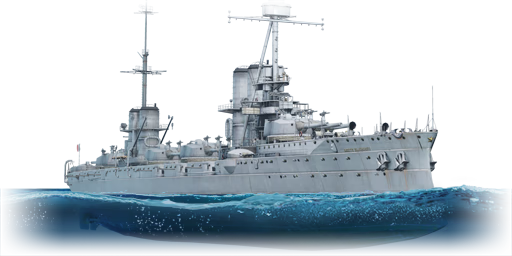The RN Dante Alighieri, launched on 20 August 1910 and entering service on 15 January 1913, was the first Italian dreadnought type battleship to be built. Despite her employment during the First World War, her service was devoid of significant events. In 1913, she embarked King Vittorio Emanuele III in Livorno to go to Castellammare di Stabia to attend the launching of the battleship Duilio. During the war, she mainly carried out patrol activities in the southern Adriatic Sea. Her only significant action during the First World War was her presence at the bombardment of the port of Durazzo on 2 October 1918; Admiral Thaon di Revel raised her insignia in protection of the Italian-British task force against retaliatory Austro-Hungarian action.
In 1923, she was refitted: all boilers were converted to run on oil, a new quadruped foremast was installed to replace the original tripod, and the funnels were lengthened to reduce the discharge of combustion smoke onto the deck. In 1925, the ship was equipped to take on board an M.18 reconnaissance seaplane and in 1927, together with the Duilio, she visited the city of Zara. At the end of the 1920s, the distressed state of the Italian economy in the aftermath of the First World War did not allow for the maintenance of a sizeable fleet, and it was therefore decided to reduce the naval budget; consequently, the construction of the Caracciolos was suspended, it was decided to dismantle the battleship Leonardo da Vinci, which had been scheduled for refit after its recovery in the port of Taranto, and to withdraw the battleships Dante Alighieri and Cavour from service. Thus, on 1 July 1928, the ship was laid up, to be decommissioned and dismantled shortly afterwards.
Introduced in Update "Red Skies", the RN Dante Alighieri manoeuvrability is not bad for a battleship. The main armament consisting of 305 mm cannons allows you to destroy even heavy and light cruisers in one shot; however, against battleships and battlecruisers, targeting weakpoints in their hulls with APHE will be required to cause them as much damage as possible. The anti-air armament is quite poor, being composed only of two 40 mm cannons. Finally, Dante Alighieri's armour proves capable of resisting both torpedoes and enemy battleships.















